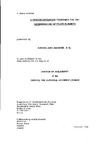A PRECONCENTRATION TECHNIQUE FOR THE DETERMINATION OF TRACE ELEMENTS
| dc.contributor.author | AMBROSE, ANDREA JANE | |
| dc.contributor.other | School of Geography, Earth and Environmental Sciences | en_US |
| dc.date.accessioned | 2013-09-11T11:47:58Z | |
| dc.date.available | 2013-09-11T11:47:58Z | |
| dc.date.issued | 1989 | |
| dc.identifier | NOT AVAILABLE | en_US |
| dc.identifier.uri | http://hdl.handle.net/10026.1/1662 | |
| dc.description.abstract |
A novel preconcentration technique for the determination of trace metal impurities in fine chemicals has been developed. The technique involved forming metal chelates in solution with Chrome Azurol S, and adsorbing them onto powdered activated carbon. Afte r separation by filtration, the enriched carbon was made into a slurry and analysed by ICP-AES. Ca, Cu, Fe(III), Mg, Mn and Ni , were all successfully adsorbed onto the carbon from water with recoveries of 100, 96, 100, 98, 97 and 100% respectively. Cu was adsorbed from aqueous solutions of glucose (30%), sucrose (20%) and potassium nitrate (10%), with recoveries of 100, 96 and 100% respectively. Adsorption equilibrium took less than five minutes. Mg was not adsorbed to any great extent in these media. Purity of the sorbent phase was a problem. Making activated carbon from cellulose by air activation produced an activated carbon low in metals, but which was unable to adsorb Fe (III) from water. Surface areas of the cellulosic carbon and commercial activated carbon using the BET equation were 420m'^g~'' and 838m^g~ ^ respectively. Clean up of commercial activated carbon by HF/HCl was investigated. A reduction of metal content was seen but high levels of Al , Ca, Mg and Fe (89.4 µ.gg~'' , 170 µgg^"* , 230 µgg"'' and 54.8 µgg"'' respectively) still remained. Although not satisfactory, this was used in subsequent experiments. Enriched carbon slurries were introduced to the plasma by flow injection as well as by continuous nebulisation. In an attempt to reduce dispersion of the flow injected sample in the carrier stream, four spray chamber designs were investigated - a Scott double pass spray chamber (SDPSC), a single pass spray chamber (SPSC), a bulbous-ended spray chamber (BESC) and a reduced volume spray chamber (RVSC). Transport efficiencies on a 1% activated carbon slurry were calculated as 0.91% for the RVSC, 0.66% for the BESC, 0.43% for the SPSC and 0.42% for the SDPSC. Simplex optimisation was used to optimise each spray chamber with regards to plasma operating conditions, for Cu and Mn. For each element, operating conditions were similar for each spray chamber. Using the optimised conditions, flow injection characteristics were investigated. There were only small differences in dispersion between each spray chamber. At higher carrier stream flow rates (4.5mlmin~* ) the BESC had the best precision (3.1%,RSD), however, further work was carried out on the RVSC which yielded Fl peaks of a Gaussian shape. The validity of the slurry atomisation FI-ICP-AES approach was confirmed by the analysis of two CRM soils, SOI and S02. For continuous nebulisation of the carbon slurries an internal standard, Sc, was used successfully to correct for variations in sample delivery and viscosity effects. Trace metal impurities (Cd, Cu, Fe, Pb and Ni) in urea, sucrose and potassium chloride were determined by the preconcentration technique both with continuous nebulisation and FI of the slurry into the ICP. The results showed quite good agreement with a liquid-liquid extraction procedure but RSDs were poor for the FI, but good with internal standardisation. | |
| dc.description.sponsorship | BDH Ltd. | en_US |
| dc.language.iso | en | en_US |
| dc.publisher | University of Plymouth | en_US |
| dc.title | A PRECONCENTRATION TECHNIQUE FOR THE DETERMINATION OF TRACE ELEMENTS | en_US |
| dc.type | Thesis | |
| plymouth.version | Full version | en_US |
| dc.identifier.doi | http://dx.doi.org/10.24382/3415 | |
| dc.identifier.doi | http://dx.doi.org/10.24382/3415 |
Files in this item
This item appears in the following Collection(s)
-
01 Research Theses Main Collection
Research Theses Main


